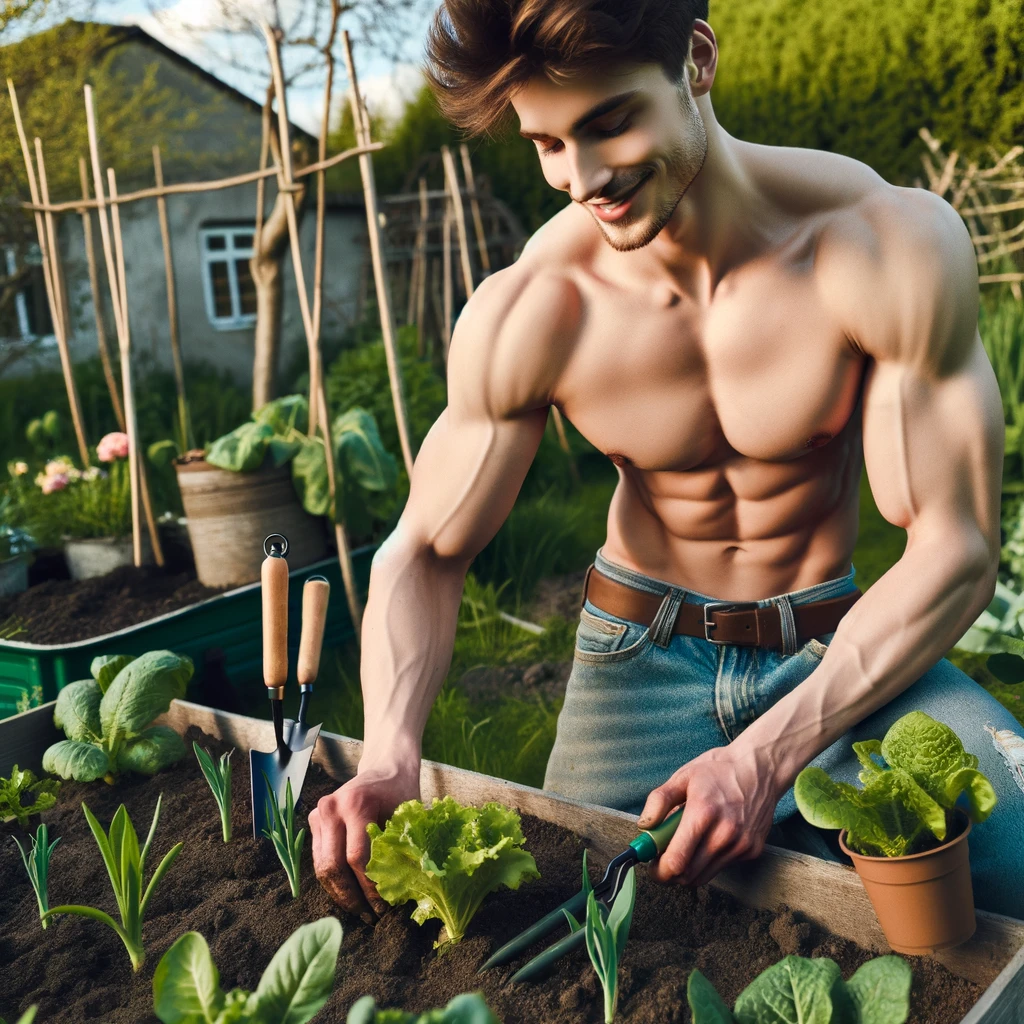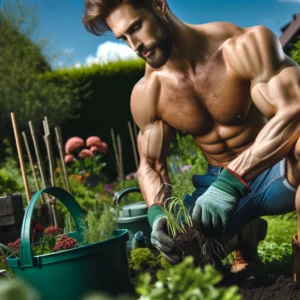
Are you a novice vegetable gardener looking to get started on your green thumb journey? Look no further! This article will provide you with essential items that every beginner gardener needs. From a reliable garden hand trowel and cultivator to help with planting and aerating the soil, to sturdy garden shears for trimming and pruning, these tools are a must-have for any budding gardener. Additionally, having garden hemp rope and bamboo garden stakes will come in handy for providing support to your growing plants. And don’t forget a rubber bin for weed collecting to keep your garden clean and tidy. With these six items in your gardening arsenal, you’ll be well-equipped to start your vegetable garden and watch it thrive.
Garden Hand Trowel
Description of garden hand trowel
A garden hand trowel is a small, handheld gardening tool with a curved metal blade. It usually has a wooden or plastic handle for a comfortable grip. The blade is typically pointed and slightly concave, making it ideal for digging, planting, and transplanting in the garden. This versatile tool is a must-have for every vegetable gardener, whether you are a novice or an experienced gardener.
Importance of garden hand trowel for vegetable gardening
The garden hand trowel plays a crucial role in vegetable gardening. Its compact size and sharp blade make it perfect for precision work in the garden. With a garden hand trowel, you can easily dig small holes for planting seeds or seedlings, transplant delicate young plants without damaging their roots, and remove weeds from the soil. It helps you maintain the proper spacing between plants, ensuring optimal growth and productivity in your vegetable garden.
How to choose the right garden hand trowel for novice gardeners
As a novice vegetable gardener, choosing the right garden hand trowel can greatly enhance your gardening experience. Here are a few tips to consider when selecting one:
- Size and Weight: Look for a trowel that feels comfortable in your hand. It should be lightweight and have an ergonomic grip that allows for easy maneuverability.
- Blade Material: Opt for a garden hand trowel with a stainless steel or carbon steel blade. These materials are durable, rust-resistant, and maintain a sharp edge for effective digging.
- Handle Material: Consider the handle material and choose one that provides a comfortable grip. Wooden handles are aesthetically pleasing but may require occasional maintenance, while plastic handles offer durability and easy cleaning.
- Blade Shape: Pay attention to the blade shape. A pointed blade helps with precise digging and planting, while a rounded blade is better suited for scooping and moving soil.
- Quality and Brand: Invest in a high-quality garden hand trowel from a reputable brand. It may cost a bit more upfront, but it will last longer and provide better performance in the long run.
Remember, a garden hand trowel is an essential tool that will accompany you through countless gardening seasons, so choose wisely!
Garden Hand Cultivator
Description of garden hand cultivator
A garden hand cultivator is a handheld gardening tool with multiple metal tines or prongs. It is designed to loosen and aerate the soil in your vegetable garden, breaking up clumps and removing weeds. The cultivator may have a wooden or plastic handle for a comfortable grip, with the tines attached to it.
Importance of garden hand cultivator for vegetable gardening
The garden hand cultivator is an indispensable tool for maintaining the health and productivity of your vegetable garden. By loosening the soil, it improves drainage, allows air to reach the plant roots, and prevents soil compaction. The cultivator helps to break up large clumps of soil, creating a crumbly texture that is ideal for root growth. Additionally, it is highly effective in removing weeds, which compete with your vegetable plants for nutrients and space.
How to choose the right garden hand cultivator for novice gardeners
When selecting a garden hand cultivator as a novice gardener, consider the following factors:
- Tine Material: Look for cultivators with tines made of durable materials such as stainless steel or carbon steel. These materials offer strength and resistance to rust, ensuring longevity.
- Tine Configuration: Consider the number and shape of the tines. A cultivator with three or four straight, sturdy tines is suitable for general cultivation and weeding. Choose a configuration that suits your gardening needs.
- Handle Design: Opt for a cultivator with an ergonomic handle that provides a comfortable grip. It should allow you to exert sufficient force without straining your hand or wrist.
- Size and Weight: Choose a cultivator that is lightweight and easy to handle. It should be compact enough to maneuver around plants but robust enough to tackle tough soil.
- Quality and Brand: Invest in a reputable brand known for producing high-quality garden tools. These tools are built to last and will serve you well throughout your gardening journey.
By choosing the right garden hand cultivator, you can maintain the health of your vegetable garden while enjoying the process of cultivating the soil.

Garden Shears
Description of garden shears
Garden shears, also known as pruning shears or secateurs, are essential tools for vegetable gardening. They consist of two sharp blades that come together to cut through stems, branches, and other plant materials with ease. The blades are typically made of high-quality steel and are attached to a handle, which can be made of wood, plastic, or metal.
Importance of garden shears for vegetable gardening
Garden shears are indispensable for maintaining the health and appearance of your vegetable plants. They allow you to prune branches, remove dead or diseased foliage, and shape your plants for better growth. Proper pruning promotes airflow and sunlight penetration, reducing the risk of diseases and improving overall plant health. With garden shears, you can also harvest vegetables without damaging the plant, ensuring a bountiful yield.
How to choose the right garden shears for novice gardeners
Choosing the right garden shears may seem overwhelming for novice gardeners, but it doesn’t have to be. Consider the following factors when making your selection:
- Blade Type: Decide between bypass shears and anvil shears. Bypass shears have two curved blades that slide past each other, providing clean cuts on live stems. Anvil shears have one straight blade that cuts against a flat surface, ideal for dead or woody stems.
- Blade Material: Look for garden shears with blades made of high-quality steel. They should be sharp, durable, and resistant to rust. Consider blades with a non-stick coating to reduce sap buildup and make cleaning easier.
- Handle Design: Choose shears that have a comfortable grip, allowing for extended use without causing hand fatigue. Ergonomic handles with cushioned grips can provide added comfort.
- Cutting Capacity: Consider the maximum cutting diameter or thickness that the shears can handle. Ensure the shears you choose are suitable for the types of plants you will be working with in your vegetable garden.
- Locking Mechanism: Look for shears with a secure locking mechanism. This will prevent the blades from accidentally opening or closing during storage, ensuring safety.
Remember to clean and oil your garden shears regularly to keep them in optimal condition. Investing in a reliable pair of garden shears will greatly assist you in maintaining the health and beauty of your vegetable plants.
Garden Hemp Rope
Description of garden hemp rope
Garden hemp rope is a natural and versatile material used in vegetable gardening. It is made from the fibers of the hemp plant and is incredibly strong and durable. Hemp rope comes in various thicknesses and lengths, allowing you to choose the right one for your gardening needs.
Importance of garden hemp rope for vegetable gardening
Garden hemp rope has numerous uses in vegetable gardening, making it an essential item for novice gardeners. Here are a few ways you can benefit from using garden hemp rope:
- Plant Support: Hemp rope is perfect for tying up and supporting tall or vining vegetable plants such as tomatoes, cucumbers, and beans. It provides a sturdy support system, preventing the plants from toppling over and ensuring they receive adequate sunlight and airflow.
- Trellising: By creating a trellis system using hemp rope, you can maximize your garden space. Trellising helps vegetables like peas and squash grow vertically, saving ground space and improving air circulation around the plants.
- Marking and Labeling: Hemp rope can be cut into smaller lengths and used to mark rows or sections in your vegetable garden. You can also use it to label the different varieties of vegetables or indicate the sowing or transplanting date.
- Securing Garden Structures: If you have DIY garden structures such as trellises, arbors, or raised beds, garden hemp rope can be used to secure and stabilize them, ensuring they withstand wind and weather conditions.
How to choose the right garden hemp rope for novice gardeners
When selecting garden hemp rope for your vegetable garden, consider the following factors:
- Thickness and Strength: Choose a rope thickness that matches the weight and rigidity of the plants you will be supporting or trellising. Thicker ropes provide greater strength, while thinner ropes are ideal for lighter plants.
- Length: Measure the distance between your plants or the size of your garden structures to determine the appropriate length of hemp rope you will need.
- Natural or Synthetic: Opt for natural hemp rope as it is biodegradable and eco-friendly. Synthetic alternatives may be more durable but are not as environmentally friendly.
- Handling and Knotting: Test the rope’s flexibility and ease of knotting. It should be pliable and easy to manipulate, allowing you to tie knots securely.
By selecting the right garden hemp rope, you can enhance the growth and stability of your vegetable plants while adding a natural and rustic element to your garden.

Bamboo Garden Stakes
Description of bamboo garden stakes
Bamboo garden stakes are long, slender poles made from bamboo, a fast-growing and sustainable material. These stakes are used to provide support and structure to your vegetable plants, ensuring they grow upright and remain stable throughout their growth cycle.
Importance of bamboo garden stakes for vegetable gardening
Bamboo garden stakes offer multiple benefits in vegetable gardening, making them an indispensable tool for novice gardeners. Here’s why they are important:
- Plant Support: Tall or heavy vegetable plants such as tomatoes, peppers, and eggplants require support to prevent them from bending or breaking under their weight. Bamboo stakes offer a strong and reliable support system, keeping the plants upright and minimizing the risk of damage.
- Pest Prevention: By attaching netting or mesh to bamboo stakes, you can create a barrier to protect your vegetable plants from pests such as birds, rabbits, or deer. This helps ensure a higher yield and reduces the risk of your harvest being decimated.
- Plant Training: Bamboo stakes can be strategically placed to train your plants to grow in a certain direction. You can gently tie the stems of vining plants to the stake, guiding their growth and optimizing space in your garden.
- Aesthetic Appeal: Bamboo stakes add a natural, rustic charm to your vegetable garden. The organic look of bamboo complements the green foliage and vibrant colors of your plants, enhancing the overall visual appeal.
How to choose the right bamboo garden stakes for novice gardeners
When choosing bamboo garden stakes, keep these factors in mind to make the right selection:
- Size and Height: Consider the height of your plants and choose stakes that are tall enough to support them effectively. Typically, stakes should be at least 1.5 to 2 times the height of the plants.
- Diameter and Strength: Look for bamboo stakes with a diameter that can withstand the weight of your plants. Thicker bamboo provides greater stability and strength.
- Quality: Inspect the bamboo stakes for any signs of damage or weakness. Ensure they are straight, without any cracks or splinters that could affect their durability.
- Sourcing: If purchasing bamboo stakes, choose ones that are sustainably sourced. Look for certifications or labels indicating that the bamboo is harvested responsibly.
- Installation: Consider how the stakes will be inserted into the soil. Some bamboo stakes come with pointed ends or metal tips for easier installation.
By selecting the right bamboo garden stakes, you can provide necessary support to your vegetable plants while adding a touch of natural beauty to your garden landscape.
Rubber Bin for Weed Collecting
Description of rubber bin for weed collecting
A rubber bin, also known as a rubber trug, is a flexible container made of durable rubber or plastic material. It is designed to be lightweight and easy to carry, making it perfect for collecting and hauling weeds, leaves, and other garden debris.
Importance of rubber bin for weed collecting in vegetable gardening
A rubber bin is an essential tool for weed collecting in vegetable gardening. Here’s why it is important:
- Efficient Weed Removal: Weeds can compete with your vegetable plants for nutrients, water, and sunlight. By using a rubber bin for weed collecting, you can efficiently remove weeds from your garden beds, ensuring that your vegetables have the best chance to thrive.
- Organization and Cleanliness: A rubber bin helps keep your gardening area organized and tidy. Instead of scattering the pulled weeds on the ground or filling multiple bags, you can conveniently collect them in the bin, reducing clutter and making cleanup easier.
- Conservation and Recycling: Using a rubber bin for weed collecting promotes sustainability. Rather than throwing the weeds away, you can compost them or dispose of them responsibly, returning nutrients to the soil or using them as mulch for future gardening projects.
How to choose the right rubber bin for weed collecting for novice gardeners
Consider the following factors when choosing a rubber bin for weed collecting:
- Size: Determine the volume of weeds you typically collect and choose a bin that offers sufficient capacity without being too heavy to carry when full.
- Material: Opt for a rubber bin made of durable and weather-resistant material. Rubber and high-quality plastics are excellent choices, ensuring that the bin withstands outdoor conditions and heavy use.
- Handles and Grip: Look for a rubber bin with sturdy handles or grips to facilitate comfortable carrying and pouring. Ensure that the handles are ergonomically designed and provide a secure grip.
- Flexibility: Choose a rubber bin that is flexible and easy to manipulate. This allows you to easily pour the collected weeds into a compost bin, wheelbarrow, or designated disposal area.
- Maintenance: Consider the ease of cleaning and maintaining the rubber bin. Look for a bin that can be easily washed or hosed down after use, preventing odors or buildup of debris.
By selecting the right rubber bin for weed collecting, you can streamline your gardening tasks and maintain a clean and organized vegetable garden.











